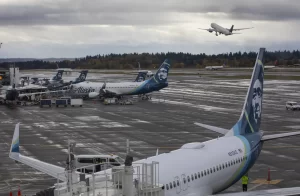We are at the start of the greatest transformation in flight since the development of the jet engine. It is not going to happen overnight, and we won’t see large, emissions-free commercial aircraft anytime soon, but like what we have witnessed with space exploration, technological advancements will continue rapidly.
Airline investments show where we are headed. Last summer, United Airlines entered into an agreement to purchase 100 electric aircraft equipped with conventional-engine backup from a Swedish startup. Air Canada is looking to acquire electric planes from the same startup, Heart Aerospace. Other companies are developing electric, hybrid and hydrogen fuel planes, including electric vertical takeoff and landing aircraft (EVTOLs), which don’t need full-length runways. Sustainable aviation fuel (SAF), a biofuel without the hydrocarbon pollution of jet fuel, has been tested in conventional jets and passed muster. Businesses are laying plans for these advances in quiet, clean, convenient aviation to be in use in one form or the other by the end of the decade.

Washington state is uniquely poised to take advantage of the opportunity and can lead the way by creating an environmentally and socially responsible airport of the future to fuel broad-based prosperity for decades to come. Our state has been carefully preparing for this moment.
Commercial aviation brings $107 billion per year in benefits to Washington. But for years, Seattle-Tacoma International Airport has been straining at the bounds of its small size. At a mere 2,500 acres, it’s less than one-tenth the size of Denver’s airport and has one of the smallest footprints of any international airport in the country. Paine Field in Everett has space to expand to serve 4.3 million passengers per year, but also has formidable geographic limitations due to the surrounding well-established neighborhoods and businesses, both on and off the airport.
By 2050, demand for flights into the Puget Sound area is projected to more than double, increasing to an estimated 100 million passengers per year. Without a change, the shortage of airport capacity will put a stranglehold on our economic growth.
That’s why, in 2019, a bipartisan effort in the Legislature created the Commercial Aviation Coordinating Commission (CACC) and tasked it with finding a solution to this shortage.
Over the last three years, the commission, of which we are members, has reviewed the state’s general aviation municipal airports within the Puget Sound area for possible expansion and was unsuccessful in finding a facility willing and able to accommodate the projected need. Next, we commissioned a study of Western Washington’s geography for possible “greenfield” sites for a new airport. The three sites currently under review are rural areas in central Pierce County east of Roy, eastern Pierce County south of Graham and central Thurston County west of Yelm. We are continuing to work on narrowing those down, as well as continuing to search for other potential new sites, with community input.
While much remains to be determined, we know this airport of the future will be very different from today’s commercial service airports. From the beginning, planning will go into environmentally responsible operations and growth as well as protecting people in the surrounding communities. Similar efforts will help us transform existing airports to make operations more environmentally sustainable.
Not only will this facilitate smoother travel to and within Washington, removing cars from roads and decreasing time in transit, it will also provide living-wage jobs and boost economic vitality in surrounding communities.
It will not replicate the airport of the past. Instead, it will be built to take advantage of tremendous technological advances with the development of sustainable aviation fuel (which will be necessary for large commercial aircraft for years to come) and the use of electric, hybrid, hydrogen-fueled planes and EVTOLs. This will lead to more energy-efficient and environmentally friendly operations.
As an environmentally responsible engine of growth, this airport of the future will be a powerful tool to improve the lives of historically disadvantaged communities denied access to the kind of good jobs and cutting-edge infrastructure that can spur shared prosperity.
We all want to leave a better state for our children and our children’s children. To achieve that better future — one with quieter, cleaner, more efficient and convenient aviation — we must imagine it now and undertake the hard work to begin building it. It will take decades, as a new airport could not be built and become operational for as many as 30 years.
Some 80 years ago, our leaders had a vision of the future, and the airport they built, Sea-Tac International, has served our state and has brought us a level of economic growth they could barely have imagined. But we have outgrown the future they framed, and now it’s time for our generation to lay a new foundation for ourselves and for the generations to come. It’s time to launch a new approach to aviation with an airport of the future.
